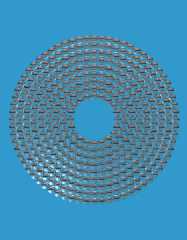While muddling around, I have come up with this. You can start see the
effect I am after, but this is truly a linear inclination. I am looking to
acheive a curved inclination all the while my spheres remain tangential. I
just can't get enough of this stuff.
Arie
"Arie L. Stavchansky" <ari### [at] bellatlantic net> wrote in message
news:3bd2d492@news.povray.org...
> Okay, this note may get a little complicated so forgive me if I confuse
you.
>
> I have written a macro that makes stacks of rings of spheres as seen in
the
> attached image. The macro adjusts the radius of the spheres in a ring
> dependant on the radius of the ring because I wanted to make sure that all
> spheres are tangential (touching each other at a tangent).
>
> Now, what I would like to do is at the top of the "cylinder of spheres" is
> start to make the rings, but so that every stack of it fits the profile i
> have drawn in. Figuring out what the radius of the ring should be and the
y
> value of the ring is very difficult for me--especially since the sphere's
> radius changes as the ring's radius gets smaller. I have attempted to
> figure this out and in the second attached image you can see my initial
> approach.
>
> Initially I have thought to define a "path" for the profile by a
polynomial
> equation. I would then input an x-coordinate value into the function with
> the equation and I would get a y-coordinate as an output. The problem is
> that when you actually go and make this a macro, how can I determine the
> change in the x value so it will give me the correct y value and STILL
have
> the sphere be tangential? In other words how do I determine the
> x-coordinate to input into the function that gives me the appropriate y
> value? Well I imagined that the change in x could be (as shown in the
> diagram):
>
> radius1*(sin theta1) + radius2(sin theta2)
>
> I have figured out how to determine the radius for each sphere of any ring
> size, but I simply can not figure out how to determine the "thetas" of
which
> to use for my equation. Am I way off? Is there an easier way to do this?
>
> F. Audet has put up his Apple code which does something similar, and I
have
> looked at it, but I am trying to understand how I can figure the math so
> that I can become more adept at making what I want. Thanks for your time
> and help I appreciate it a great deal since it has helped me realize the
> images I see in my head :)
>
> Arie
>
>
> net> wrote in message
news:3bd2d492@news.povray.org...
> Okay, this note may get a little complicated so forgive me if I confuse
you.
>
> I have written a macro that makes stacks of rings of spheres as seen in
the
> attached image. The macro adjusts the radius of the spheres in a ring
> dependant on the radius of the ring because I wanted to make sure that all
> spheres are tangential (touching each other at a tangent).
>
> Now, what I would like to do is at the top of the "cylinder of spheres" is
> start to make the rings, but so that every stack of it fits the profile i
> have drawn in. Figuring out what the radius of the ring should be and the
y
> value of the ring is very difficult for me--especially since the sphere's
> radius changes as the ring's radius gets smaller. I have attempted to
> figure this out and in the second attached image you can see my initial
> approach.
>
> Initially I have thought to define a "path" for the profile by a
polynomial
> equation. I would then input an x-coordinate value into the function with
> the equation and I would get a y-coordinate as an output. The problem is
> that when you actually go and make this a macro, how can I determine the
> change in the x value so it will give me the correct y value and STILL
have
> the sphere be tangential? In other words how do I determine the
> x-coordinate to input into the function that gives me the appropriate y
> value? Well I imagined that the change in x could be (as shown in the
> diagram):
>
> radius1*(sin theta1) + radius2(sin theta2)
>
> I have figured out how to determine the radius for each sphere of any ring
> size, but I simply can not figure out how to determine the "thetas" of
which
> to use for my equation. Am I way off? Is there an easier way to do this?
>
> F. Audet has put up his Apple code which does something similar, and I
have
> looked at it, but I am trying to understand how I can figure the math so
> that I can become more adept at making what I want. Thanks for your time
> and help I appreciate it a great deal since it has helped me realize the
> images I see in my head :)
>
> Arie
>
>
>
Post a reply to this message
Attachments:
Download 'capTop.jpg' (81 KB)
Download 'capPersp.jpg' (43 KB)
Preview of image 'capTop.jpg'

Preview of image 'capPersp.jpg'

|




![]()